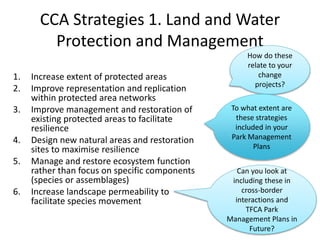CCA strategies for biodiversity conservation contexts
- 1. CCA Strategies for Biodiversity Conservation Contexts Reflections on your Change Projects Climate Change Adaptation and Mitigation for Trans-frontier Conservation Areas in southern Africa Day 2, session 2
- 2. General Adaptation Strategies 5 Broad Categories: 1) Land and Water Protection and Management 2) Direct Species Management 3) Monitoring and Planning 4) Law and Policy 5) Community-based ecosystem adaptation
- 3. CCA Strategies 1. Land and Water Protection and Management 1. Increase extent of protected areas 2. Improve representation and replication within protected area networks 3. Improve management and restoration of existing protected areas to facilitate resilience 4. Design new natural areas and restoration sites to maximise resilience 5. Manage and restore ecosystem function rather than focus on specific components (species or assemblages) 6. Increase landscape permeability to facilitate species movement How do these relate to your change projects? To what extent are these strategies included in your Park Management Plans Can you look at including these in cross-border interactions and TFCA Park Management Plans in Future?
- 4. CCA Strategies 2: Direct Species Management 1. Focus conservation resources on species that might become extinct 2. Translocate species at risk of extinction 3. Establish captive populations of species that would otherwise go extinct 4. Reduce pressures on species from sources other than climate change How do these relate to your change projects? To what extent are these strategies included in your Park Management Plans Can you look at including these in cross-border interactions and TFCA Park Management Plans in Future?
- 5. CCA Strategies 3: Monitoring and Planning 1. Conduct Regular Risk and Vulnerability Assessments and Evaluate and Enhance Monitoring Programmes for Wildlife and Ecosystems 2. Incorporate Predicted climate-change impacts into species and land- management plans, programmes and activities 3. Develop dynamic landscape conservation plans 4. Ensure wildlife and biodiversity needs are considered as part of the wider societal adaptation process How do these relate to your change projects? To what extent are these strategies included in your Park Management Plans Can you look at including these in cross-border interactions and TFCA Park Management Plans in Future?
- 6. CCA Strategies 4: Law and Policy 1. Review and modify existing laws, regulations and policies regarding wildlife and natural resources management to include effects and risks of climate change 2. For TFCA context, look into harmonisation of cross-border laws, policy, management and enforcement practices around common concerns related to climate change How do these relate to your change projects? To what extent are these strategies included in your Park Management Plans Can you look at including these in cross-border interactions and TFCA Park Management Plans in Future?
- 7. CCA Strategies 5: Community-based ecosystem adaptation 1. Agro-forestry and conservation agriculture 2. Diversification of livelihood options for communities 3. Afforestation programmes 4. Rainwater harvesting 5. Sustainable use policies and programmes How do these relate to your change projects? To what extent are these strategies included in your Park Management Plans Can you look at including these in cross-border interactions and TFCA Park Management Plans in Future?
- 8. ŌĆ£Managers may still be using many of the same tools, but they will increasingly need to view the ways in which they use these tools through the lens of climate-induced changes to species and ecosystems. Our old, static views of biodiversity will need to yield to new and dynamic understandings of changing ecosystems and changing climatesŌĆØ








